Squalidae, more commonly known as dogfish, dog sharks, or spiny dogfish, are one of several families of sharks categorized under Squaliformes, making it the second largest order of sharks, numbering 119 species across 7 families. Having earned their name after a group of fishermen reportedly observed the species chasing down smaller fish in dog-like packs, dogfish have slender, streamlined bodies, usually more compact in comparison to other species, and a pointed snout. Dogfish likewise have two dorsal fins, each with smooth spines, but no anal fin, and their skin is generally rough to the touch. As the species reaches adulthood, males usually measure a maximum of 39 inches, while females typically measure 49 inches long. The species therefore exhibits female-dominant sexual dimorphism.
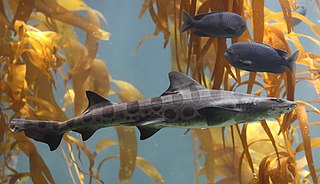
Houndsharks, the Triakidae, are a family of ground sharks, consisting of about 40 species in nine genera. In some classifications, the family is split into two subfamilies, with Mustelus, Scylliogaleus, and Triakis in the subfamily Triakinae, and the remaining genera in the subfamily Galeorhininae.

The graceful shark or Queensland shark is a species of requiem shark, in the family Carcharhinidae, found in the tropical Indo-Pacific, from the Gulf of Aden to northern Australia. It is a midwater species that has been recorded to a depth of 50 m (160 ft). A stoutly built shark growing up to 1.7 m (5.6 ft) long, the graceful shark has a short, wedge-shaped snout, large, sickle-shaped pectoral fins and first dorsal fin, and black tips on most fins.

The Borneo shark is a species of requiem shark, and part of the family Carcharhinidae. Extremely rare, it is known only from inshore waters around Mukah in northwestern Borneo, though it may once have been more widely distributed. A small, gray shark reaching 65 cm (26 in) in length, this species is the only member of its genus with a row of enlarged pores above the corners of its mouth. It has a slender body with a long, pointed snout and a low second dorsal fin placed posterior to the anal fin origin.
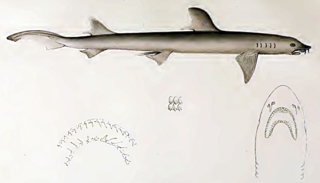
The barbeled houndshark is a species of ground shark and the only member of the family Leptochariidae. This demersal species is found in the coastal waters of the eastern Atlantic Ocean from Mauritania to Angola, at depths of 10–75 m (33–246 ft). It favors muddy habitats, particularly around river mouths. The barbeled houndshark is characterized by a very slender body, nasal barbels, long furrows at the corners of the mouth, and sexually dimorphic teeth. Its maximum known length is 82 cm (32 in).

The sicklefin weasel shark is an uncommon species of ground shark in the family Hemigaleidae. It is native to southern India, southern China, and parts of Southeast Asia, living in shallow waters down to a depth of 170 m (560 ft). This lightly built shark is characterized by its very short mouth, broad upper teeth with serrations only on the trailing edge, and strongly sickle-shaped fins with obvious white tips on the two dorsal fins. It is light grey or bronze in colour, often with small white blotches on its sides; it reaches a maximum known length of 1.1 m (3.6 ft).
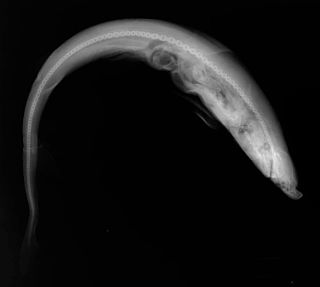
The Atlantic weasel shark is a weasel shark of the family Hemigaleidae, found in the eastern Atlantic Ocean. Also known as the little tiger shark, it is the only species of the genus Paragaleus to have been recorded off the western coast of Africa. It is one of four species of small sharks within the carcharhinoid genus Paragaleus, including Paragaleus leucolomatus, Paragaleus tengi, and Paragaleus randalli. It also one of eight species within the weasel shark family, Hemigaleidae. It is currently considered by the International Union for Conservation of Nature (IUCN) as Endangered.

The pygmy ribbontail catshark is a species of finback catshark, family Proscylliidae, distributed patchily in the western Indo-Pacific from Tanzania to the Philippines. It occurs around the edges of continental and insular shelves at a depth of 71–766 m (233–2,513 ft), typically on or near mud bottoms. One of the smallest living shark species, the pygmy ribbontail catshark grows to a maximum known length of 24 cm (9.4 in). It has a slender body with a low, ribbon-like tail fin, and is dark brown in color with blackish dorsal fin markings and tail bands. This shark feeds mainly on bony fishes, followed by crustaceans and then squid. It is aplacental viviparous with females bearing litters of 1–2 relatively large pups. It is of minimal significance to fisheries, being caught as bycatch in some areas.

The Indian swellshark is a catshark of the family Scyliorhinidae found in the western Indian Ocean from Quilon, India and Sauqira Bay, Oman between latitudes 16° N and 10° N, from the surface to 300 m. It grows to about 36 cm in length, and can expand its body by taking in air or water to make it appear larger to predators.

The whiskery shark is a species of houndshark in the family Triakidae, and the only member of its genus. This common shark inhabits the Australian continental shelf from Western Australia to the Bass Strait, to a depth of 220 m (720 ft). It is demersal in habits and prefers rocky and vegetated habitats. Stout-bodied and almost "humpbacked" in form, the whiskery shark can be distinguished from all other members of its family by the presence of long nasal barbels. Its two moderately large dorsal fins are roughly equal in size. It is brownish gray above and lighter below, with a pattern of darker saddles and blotches in younger sharks. This species reaches 1.6 m (5.2 ft) in length.
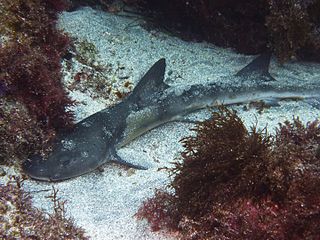
Hemitriakis is a genus of houndsharks in the family Triakidae.

The spotted houndshark, Triakis maculata, is a houndshark of the family Triakidae found in tropical waters in the eastern Pacific Ocean off the coast of South America. It usually grows to a length around 180 centimetres (71 in). The reproduction of this houndshark is ovoviviparous, with a litter of 14 pups being found in one female with a birth size of 30 to 40 centimetres. Their diet is believed to consist mainly of crustaceans.

The sharptooth houndshark, or spotted gully shark is a species of houndshark in the family Triakidae found in shallow inshore waters from southern Angola to South Africa. Favoring sandy areas near rocky reefs and gullies, it is an active-swimming species that usually stays close to the bottom. This robust shark reaches 1.7 m (5.6 ft) in length and has characteristically large, rounded fins; the pectoral fins in particular are broad and sickle-shaped in adults. It also has a short, blunt snout and long furrows around its mouth. This species is gray or bronze in color above, with variable amounts of black spotting.

The banded houndshark is a species of houndshark in the family Triakidae, common in the northwestern Pacific Ocean from the southern Russian Far East to Taiwan. Found on or near the bottom, it favors shallow coastal habitats with sandy or vegetated bottoms, and also enters brackish water. This shark reaches 1.5 m (4.9 ft) in length. It has a short, rounded snout and mostly narrow fins; the pectoral fins are broad and triangular, and the trailing margin of the first dorsal fin is almost vertical. It is gray above and lighter below; younger sharks have darker saddles and dots, which fade with age.

The whitefin topeshark is a houndshark of the family Triakidae, found only in the tropical waters of the Philippines between latitudes 20° N and 5° N. They inhabit the coastal areas. They can grow up to a length of 96 cm. Adolescent specimens have dark areas on their caudal fins. The reproduction of this shark is ovoviviparous.

The spotless smooth-hound is a species of houndshark, in the family Triakidae, found on the continental shelves of the northwest Pacific, between latitudes 40° N and 11° N, from the surface to a depth of 300 m. It can grow to a length of up to 1 m.
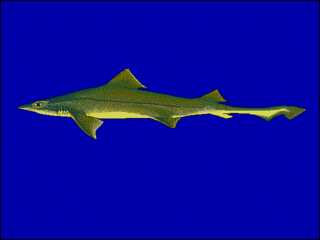
The speckled smooth-hound is a houndshark of the family Triakidae. It is found on the continental shelf of the eastern Pacific, between latitudes 0° and 54° S, at depths between 16 and 50 m. It can reach a length of 130 cm (51 in). Collectively with certain other species of shark, it is known as "tollo".

The African sawtail catshark is a species of catshark, part of the family Scyliorhinidae. Demersal in nature, it is found at depths of 160–720 m (520–2,360 ft) off the western African coast from Morocco to South Africa. This slender species has a rather long, pointed snout, a series of dark saddles along the back and tail, and a prominent crest of enlarged dermal denticles along the upper edge of the caudal fin. Its maximum known length is 46 cm (18 in).

The longtail butterfly ray is a species of butterfly ray, family Gymnuridae, native to the Indo-Pacific from the Red Sea to southern Japan and western Indonesia. Growing up to 92 cm (36 in) across, this ray has a lozenge-shaped pectoral fin disc about twice as wide as long, colored brown to gray above with many small, light spots. The spiracles behind its eyes have smooth rims. This species can be identified by its tail, which is about as long as the snout-to-vent distance, lacks fins, and bears nine to twelve each of alternating black and white bands.
The Indonesian speckled catshark is a species of catshark in the genus Halaelurus. It is a tropical catshark found in the Pacific Ocean. It was named by W. T. White, P. R. Last, and J. D. Stevens in 2007. Male Halaelurus maculosus can reach a maximum length of 45.7 centimetres (18.0 in), while females can reach a maximum length of 52.8 centimetres (20.8 in). Catsharks in this species are occasionally caught by demersal fisheries.


















